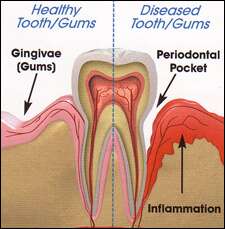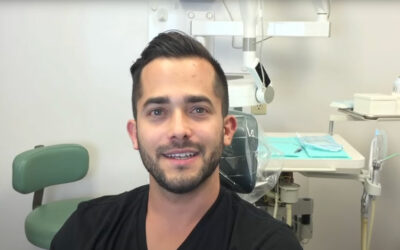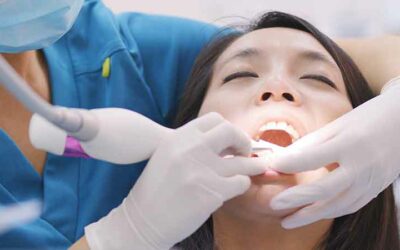Why Your Gums Shouldn’t Have Pockets and What Your Periodontist Can Do About Them
For healthy mouths, gums should fit snugly around each tooth, with the distance between the gum and the tooth attachment measuring only 1-3 millimeters. However, if you suffer from gum disease, deeper spaces (called periodontal pockets) can form around your teeth. If left untreated, these pockets can lead to several dental problems, including tooth loss. Early diagnosis and treatment of gum disease are essential in order to keep your teeth and gums healthy.
One of the best ways to avoid gum disease and the creation of periodontal pockets is with a good oral health regimen and regular check-ups with a gum disease specialist. Our team of periodontists at the CENTER for Advanced Periodontal & Implant Therapy in Los Angeles are experts in the latest treatments for eliminating gum disease that helps reduce your risk of developing oral health issues like periodontal pockets.
What is a Periodontal Pocket?
 If you’ve looked at your teeth and gums in the mirror, you may have noticed that the top of the gum tissue doesn’t actually attach directly to the tooth. There is a small space between your tooth and gums and this space is called a sulcus. Unfortunately, this area can become clogged with both bacteria and food particles. For the most part, these can be removed with brushing and flossing, but in general, most toothbrushes lack the ability to reach the necessary 2-3 millimeters below the gum line. If the sulcus happens to be deeper than this, the bacteria and food particles will remain and can build up below the gum line, leading to both inflammation and/or swelling.
If you’ve looked at your teeth and gums in the mirror, you may have noticed that the top of the gum tissue doesn’t actually attach directly to the tooth. There is a small space between your tooth and gums and this space is called a sulcus. Unfortunately, this area can become clogged with both bacteria and food particles. For the most part, these can be removed with brushing and flossing, but in general, most toothbrushes lack the ability to reach the necessary 2-3 millimeters below the gum line. If the sulcus happens to be deeper than this, the bacteria and food particles will remain and can build up below the gum line, leading to both inflammation and/or swelling.
If left untreated, the gum tissue can begin to separate and even pull away from the teeth. This leaves a large space between the tooth and gum where destructive bacteria can grow.
This enlarged space is what periodontists refer to as a pocket, which can store bacteria. If the bacteria are allowed to accumulate, this can lead to loss of healthy bone and gum tissue beneath the gum line. Eventually, the bacteria present in the periodontal pocket will erode the structures that hold the teeth in place, potentially leading to tooth loss.
How are Gum Pockets Treated?
As part of your normal check-up, your periodontist will use a special tool called a periodontal probe that is used to measure the gap where the tooth meets the gum. The periodontist will take six measurements, in millimeters, around each tooth: three on the outer (lip) side and three on the inner (tongue) side. These measurements help identify any changes in your gum health over time and can pinpoint periodontal pockets.
Professional Cleanings
Each periodontal pocket can vary, and treatment will depend on factors like depth, shape, and whether inflammation is restricted to the gum tissue or if it has spread to the underlying bone. The first step in treating gum pockets is by removing the plaque bacteria and tartar. In cases of periodontal disease that has caused inflamed gums with no bone loss, professional cleanings with your periodontist and a comprehensive at-home oral health regimen will remove the causes of the inflammation causing the pocket.
A complete at-home oral health routine will include:
- Brushing your teeth twice a day with a soft toothbrush and fluoride toothpaste
- Flossing daily to remove plaque from between the teeth where your brush can’t reach
- Using an oral rinse, if recommended by your dentist
Scaling and Root Planing
If a patient has a more severe level of periodontal disease, a procedure called scaling and root planing may be needed. With this comprehensive cleaning procedure, the periodontist is able to remove the plaque and tartar as well as smooth out the root surface, which allows the gum tissue to reattach to the tooth, effectively shrinking the periodontal pocket.
RejuvaGum Lift
An innovative treatment for periodontal pockets is the RejuvaGum Lift. This regenerative medicine treatment can help reverse gum disease and improve periodontal pockets non-invasively and effectively.
With the RejuvaGum Lift, Dr. Aalam or Dr. Krivitsky use a small amount of the patient’s blood that is put in a device called a centrifuge. The centrifuge separates white blood cells and platelets, which are used to create a platelet-rich fibrin. The periodontist will insert the fibrin into the gums near the pocket helping jumpstart the body’s own natural healing powers. This initiates regrowth of the gums, reducing the size of the pocket and aiding in protecting the tooth roots.
You May Also Like...
Understanding TMJ Jaw Pain and Seeking Specialist Help
Navigating the complexities of jaw pain requires a deep dive into the various causes and conditions that lead...
Stem Cells Tissue Regeneration: An Alternative to Classic Gum Graft
Gum recession is a common dental problem that affects millions of people worldwide. This condition occurs when the...
Deep Cleaning Teeth With Scaling And Root Planing
If you have gum disease, the best way to treat periodontitis is to remove hard-to-reach tartar buildup through scaling...



